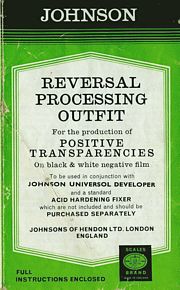| Johnsons Developers & Negative Treatments |
|
|
|
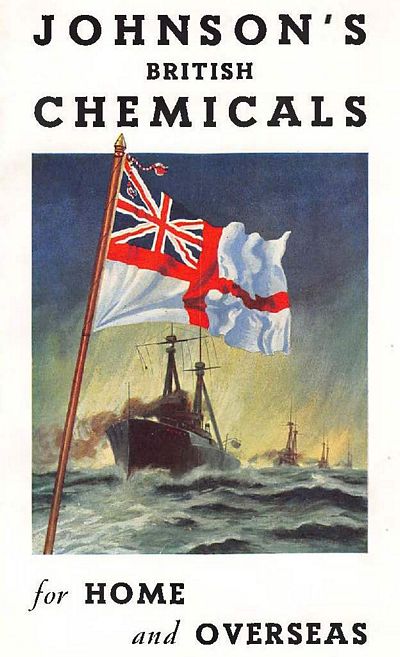 |
Left: A patriotic advertisement from the British Journal Photography Almanac (BJPA) for 1940, after the 3rd September 1939 of Britain's entry into the 2nd World War. For a basic understanding about the chemistry of developers, read my web page here. In 1950 there was a wide variety of developers and negative modifying agents available from Johnsons of Hendon for those wishing to carry out home processing of black & white films and papers. Apart from Wellcome's 'Tabloid' range, the following appear in the range of advertising booklets shown on the Johnson Way to Better Photography page. Indicative costs quoted below are generally for the 1950s, but some are 1960s. Earlier versions of some of the 1950s chemicals have been added to the page (below) since it was first uploaded. The earliest is a pack of Gold Toning 'Scaloid' chemicals, which date to pre-1927. Johnson's also supplied, from 1939, processing kits for the additive transparency DufayColor film, for 3s/9d (19p). By the 1950s, the kit price had risen to 12s 6d (62.5p; processed 4 films). Liquid chemicals were supplied in 'Rigidex' plastic bottles, instead of glass, from early September 1961. By 1970 the number of amateur products was much reduced, probably reflecting the reduced number of amateurs using black & white film and a home darkroom to produce monochrome prints. By 1970, most amateurs were either taking colour slides or using merchant d&p colour printing. For 'Jingles' that extolled the use of Johnson's Chemicals, see my web page here. |
|
|
|
|
AZOL A British-made chemical derived from paramidophenol. Johnson & Sons sold 'Azol' even before their 1927 relocation from Finsbury to Hendon. A highly concentrated developing solution for films, plates, lantern plates and all types of paper. It only requires diluting with water to be immediately ready for use. The leaflet, opposite, gives film developing times for dilutions of 1:24 & 1:40 and advises times for dilutions up to 1:100. Bromide paper 1:24 and Contact Paper 1:16. The concentrated solution will keep for years. Cost 100cc 3/- (15p), 200cc (22.5p), 500cc (49p). In 1965 100cc cost 4s (25p) and 250cc cost 6s.6d (32.5p) A pre-1927 Johnson & Sons 'Azol' bottle found in the Antarctic (link now broken). Believed to have been taken to the Antarctic by the ill-fated expedition of Captain Robert Scott in 1910. 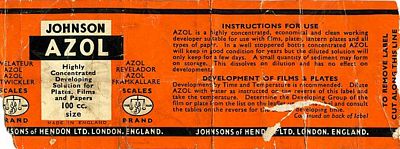 |
Another Azol leaflet, believed to date to 1954 (maybe 1950), can be downloaded as a pdf file here. |
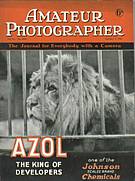 AZOL,
The King of Developers AZOL,
The King of Developers |
|
 |
Demonstraating the long history of Johnson's 'Azol' developer, the image alongside, of an early bottle of Azol, has been sent to me by Stephanie McIsaac. She writes: Moulded into the glass of the
bottle is the Johnson and Sons 'Scales Brand' trademark. Below
that it reads: Notice it is called The 'ACTIVE' Developer, whereas the later packaging (see below), refers to Azol as The 'CORRECT' Developer. |
|
The label on the front of a box that once contained an early 3 fluid ounce bottle of Azol (courtesy of Brian Rees). The Johnson & Sons address of 23, Cross Street, Finsbury, London, dates this Azol packaging to pre-1927. Notice it is called The 'ACTIVE' Developer, whereas the later, similar style, packaging below, calls Azol The "CORRECT" Developer. |
|
|
The instruction sheet is the same as that accessible by clicking on the page images above. |
|
|
|
|
|
UNIVERSOL One developer for all your photographic work. Prepared from a new and concentrated M-Q formula and contains Johnson 142 for prevention of fog and stains and Johnson 326, a wetting agent. In daylight developing tanks dilute 1:15. Also excellent for contact prints producing rich, blue-black prints with a wide range of tones. Cost 225cc 2/6d (12.5p), 570cc 4/- (20p). In 1965, 250cc cost 4s.3d (21.5p) and 500cc cost 6s.6d (32.5p) 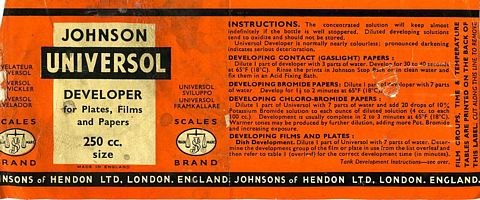 |
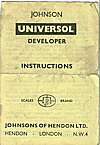 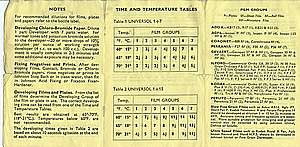 |
 Click
on any of these images to enlarge them. Click
on any of these images to enlarge them. |
|
|
Photo Technology Ltd ~ Johnson UNIVERSOL From 1976, the residual Johnson black & white processing chemistries were being sold by Photo Technology Ltd. This was an outcome of the 1972 acquisition of Johnsons of Hendon by the Hestair Company and its major restructuring; Johnson abandoned chemical production altogether in 1974. Alongside is the instruction leaflet that accompanied Universol developer in April 1977. The price written on the instructions is 71p |
.jpg) .jpg) .jpg) .jpg) Click
the images to enlarge. Click
the images to enlarge. |
|
|
|
|
FINE GRAIN "A popular and reliable M.Q/Borax developer giving full emulsion speed and negatives of excellent enlarging quality." In all the Johnson booklet describing this developer it is claimed that "negatives on medium speed films can be enlarged 10-12 diameters" but curiously, in the 1957 instructions shown alongside, the claim is modified to "....suitable for....all types of 35mm films, roll films and plates, producing negatives which may be enlarged to about 8 diameters without noticeable grain." Available in various sized tins to make 1 gallon and more, or as a Pactum to make 570ccs (20 fluid ounces), capable of developing 5 or 6 off 120 roll films or full length 35mm films, provided that development was increased by about 10% after each film. The developer had to be made up to the full working volume, not more and not less ! "After use the solution becomes cloudy or precipitates a small quantity of grey sediment. This is quite normal and does not affect the developing properties ...should be filtered or decanted for (further) use." A tin to make 570cc (20 fluid ounces) cost 1/6d (7.5p) in the early 1950s, but the price for a 20fluid ounce Pactum cost 3shillings (15p) by 1965. |
The above dates to July 1957. Another leaflet for Fine Grain developer, dating to February 1969, can be downloaded as a pdf here. |
|
|
|
|
SUPER FINE GRAIN Contains Meritol and produces negatives that can be enlarged 20 diameters without showing traces of grain. Tins of powder that dilute to make 570cc of solution (20 fluid ounces) and develop 4 or 5 35mm or roll films. Cost per tin, 2/6d (12.5p).
|
A set of instructions dating to late 1954. Click on either image to view enlarged versions. |
|
|
|
|
HYDROQUINONE The bottle shown alongside is dated August 1937 and was produced by Johnson & Sons, Manufacturing Chemists Ltd, Hendon, London. It contained 4ounces (oz) of Hydroquinone. Hydroquinone has a variety of uses principally associated with its action as a reducing agent that is soluble in water. It is a major component in most photographic developers for film and paper where, with the compound Metol (see M-Q, below), it reduces silver halides to elemental silver. These images have been sent to me by Rohan Green (see Rohan's Images). |
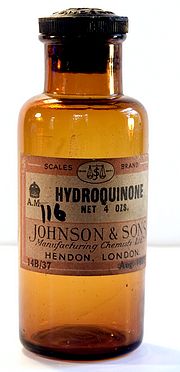  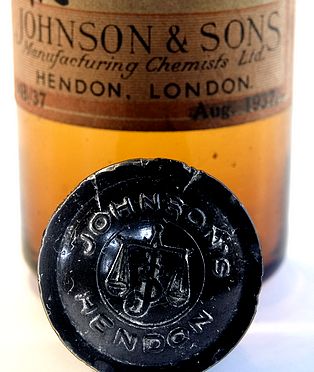 |
|
|
|
|
METOL-QUINOL (M-Q) Metol is methyl-p-aminophenol.
Quinol is an abbreviation for hydroquinone. In tins to make 2280cc of stock solution which is diluted 1:1 to develop contact prints or 1:3 to develop bromide papers or films. Cost 4/3d (21.5p), 1953 cost 6/- (30p). Cost to make 570cc stock solution 2/9d (14p). Handy 'Pactums' dilute to 145cc and develop 36 contact prints, or to 570cc and develop two 120 films. Cost 5d (2p). Twin Pactums in 1953 1/3d (6p). |
 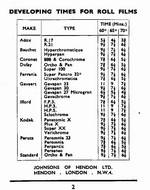 Click
on the images to enlarge them. Click
on the images to enlarge them. |
|
The pacakaging arrangement seems to have been two rows wide, three Pactums deep, per row. |
This pack shows an advertisement for tins of Johnsons Acid Fixing Powder and also for various packagings of Johnsons Print Tonings Solutions, Scaloids & Pactums.(blue, green, red and sepia). |
| In 1953, and for maybe a decade thereafter, Johnsons distributed 'Tabloid' brand photographic products, originally a novel range of pelletised photographic chemicals sold by Burroughs Wellcome. Their tablet form made them popular during Empire and war years for their convenience of being easily transported to far flung outposts and having good keeping qualities. | |
|
But the Johnson statement may have been just a half truth. Johnsons may have supplied the premixed photographic chemicals to Burroughs Wellcome, and Burroughs Wellcome then did the "manufacturing" by pelletising the chemistry powder into compressed tablets. The pictures below, sent by Dave Dockerill, show a pack of very similar tablet form (M-Q) developer, but sold by Johnson & Sons as 'Scaloids'. |
To view the instruction leaflet, click here. |
| The 'Scaloid'
brand name is presumably a combination of the Johnsons 'Scale
Brand' and the Burroughs Wellcome 'Tabloid' brand. Scaloid tablets
(for developers, toning and intensifiers etc) are mentioned in
the 1943 BJPA. But Dave Dockerill tells me he has found reference
to 'Scaloids' and Johnsons in a Royal Photographic Society (RPS)
catalogue dated 1909. In that case, it is possible that Johnsons
were involved with Burroughs Wellcome from the earliest times
of photographic Tabloid chemical manufacture and it can be conjectured
that Johnsons perhaps always supplied photographic chemicals
to Burroughs Wellcome, and Burroughs Wellcome provided their
pelletising idea and technology to turn the powder chemicals
into compressed tablets. Perhaps in exchange for the photographic
chemicals, Burroughs Wellcome allowed Johnsons to sell the same
compressed tablets under the Scaloid brand name, despite competition
with the Tabloid range. The M-Q Scaloid pack shown below must date post-1927 as the address for Johnson & Sons is shown as Hendon. |
|
 |
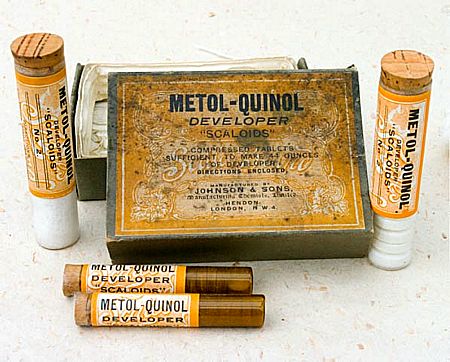 |
| Twin Pactum M.Q. Developer "468" Formula | |
|
Full instructions can viewed by clicking the thumbnail images opposite. These date to April 1959 when the Twin Pactum cost 1s/3d (6.5p). Such twin-packet Pactums would cost less than £2 in 2024. If only they were still available!! Johnsons stopped selling their Pactum range of chemicals in 1968. |
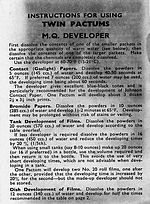 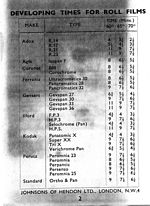 Click here,
on on the images (left), to view enlarged versions Click here,
on on the images (left), to view enlarged versions |
|
MERITOL-METOL Meritol is a combination of paraphenylene diamene and pyrocatechin in molecular proportions, patented (Patent 466625) by Johnson & Sons Ltd. For small negatives a fine grain developer containing Meritol is recommended. Metol is methyl-p-aminophenol. Meritol-Metol combines the fine grain properties of Meritol with the quicker action of Metol. Supplied in tins of powder to make 570cc or 570cc bottles of ready to use solution. Cost of tins 2/6d (12.5p) and bottles 3/6d (17.5p). Ian Grant contributing to the
APUG Forum here, (and who also sent the advert extreme
RHS), believes the formula for Meritol-Metol is: Where 14gms Meritol = 6.13gms paraphenylene diamene + 7.88gms pyrocatechin |
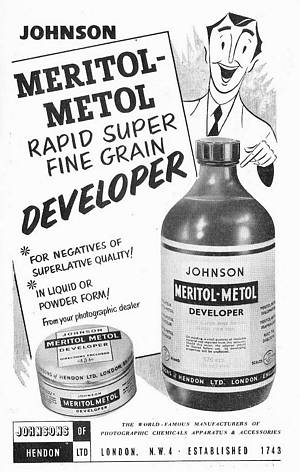 The advert above was provided by Paul Godfrey from a c1952 book 'The Manual of the Miniature Camera' by T.L.J.Bentley. |
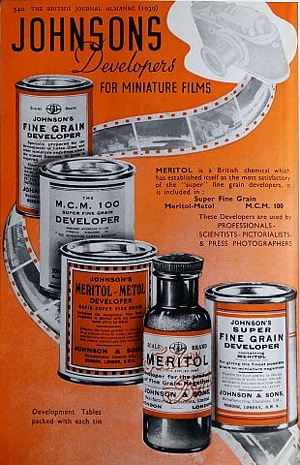 Thie above BJPA 1939 advert (courtesy of Ian Grant) states "MERITOL is a British chemical which has established itself as the most satisfactory of the "super" fine grain developers ...." |
|
|
|
|
MCM 100 Another excellent fine grain
developer containing Meritol. Prepared to a special formula published
in the Miniature Camera Magazine (MCM). The formula taken from
the BJPA of 1952 is: The benefit is that it can be used diluted without loss of its fine grain properties. Tins to make 570cc Cost 3/- (15p) |
 Click on the images to enlarge them. |
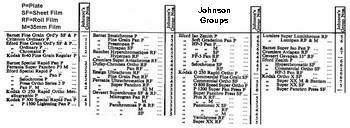 |
|
|
|
|
|
AMIDOL
Sold as small 'Pactums', each sufficient for 285cc of developer for bromide papers or films. Each Pactum cost 7½d (3p). Also in 28.5cc bottles at 3/6d (17.5p). The 4fl.oz (113ml) bottle of Amidol shown alongside was manufactured by Johnsons, for Ilford Ltd. Picture courtesy of Ian Grant. |
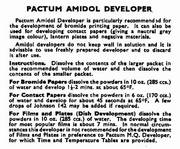 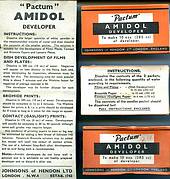 |
|
Click here, or on the images, to see the instruction leaflet that accompanied this packaging. |
|
|
|
|
|
CONTRAST Originally introduced to meet the demands of press photographers requiring a quick acting developer for both negatives and prints. It produces brilliant, sparkling prints, particularly suitable for reproduction. Highly concentrated it may be diluted to obtain almost any effect. For bromide papers a dilution of 1:10 is recommended. Cost 225cc 2/6d (12.5p) and 570cc 4/- (20p). The instructions below are seemingly code dated 1950, but they refer to Johnsons by their pre-1949 name of Johnson & Sons, Manufacturing Chemists. |
|
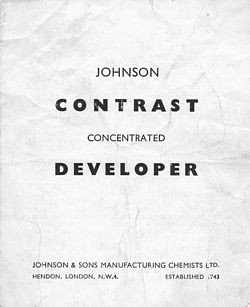 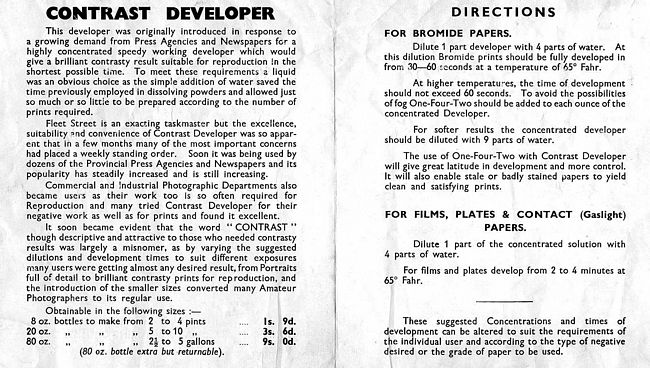 |
|
|
|
|
|
CHLOROQUINOL For warm tones on all makes and grades of chlorobromide paper. Keeps well either in its concentarted form or after dilution. Invaluable to portrait & pictorial photographers for the production of warm tones from warm black to sepia. Dilute 1:8 parts water. Less
temperature sensitive than hydroquinone. |
BROMIDE DEVELOPER Johnson Bromide Developer is specially prepared for all makes and grades of bromide paper. It works rapidly and has excellent keeping qualities and possess a considerable degree of latitude. Highly concentrated, dilute
with 7 parts water. |
|
|
|
|
HYDROQUINONE, SCALOL, PHENIDONE The photograph alongside is by courtesy of Fernando Sousa Lopes of Porto in Portugal. It shows glass bottles, probably
dating from the 1950s (maybe 1960s) of three well known black
& white film & paper developing agents, though the middle
bottle has the less familiar trade name of 'Scalol'. 'Phenidone' was an Ilford proprietary developing agent, chemical name l-Phenyl-3-Pyrazolidone. It was first prepared in 1890, however it was not until 1940 that Dr.J.D.Kendall, in the Rodenside laboratories of Ilford, Limited, discovered the photographic reducing properties of this chemical as an alternative to 'Metol'. |
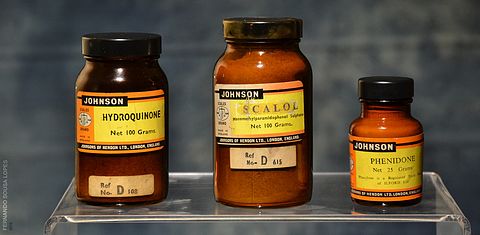 |
|
|
|
|
UNITOL Introduced December 1950. This concentrated liquid fine grain developer introduced a new system whereby 1fluid ounce (28.5cc) of fresh developer could be diluted for use and the whole discarded afterwards. Grain fine enough for 12 to 14 diameter enlargement. Keeping properties of the undiluted liquid are excellent. Approx ½stop of film speed loss. Cost for a 225cc, 8oz, bottle
3/6d (17.5p), 570cc, 20oz (1 pint) 6/6d (32.5p). 'Good Photography' magazine for November 1961 carried an announcement that Johnsons of Hendon had filled their one-millionth bottle of Unitol. This meant enough developer had been manufactured to process 16.5 million films in 10 years. |
 Click on the image to enlarge. |
 |
 |
 |
|
Click on the images above to enlarge. |
||
| Unitol - New Formula | ||
|
As can be read on my Photo Technology web page, in Spring 1974 Johnsons ceased manufacture of photographic chamicals and the newly emerging company of Photo Technology acquiired the Rights to the Johnsons of Hendon Scale Brand logo and began to market some of the previous Johnson monochrome chemicals. Amongst these was Unitol. Eventually Photo Technology became part of the Paterson Photax Group and finally Paterson Photographic Ltd. The instructions (alongside) for 'New Formula' Unitol were produced by Photo Technology Ltd, possibly around 1980. They certainly date beyond 1976, as they include processing information for Ilford HP5, but seemingly before Unitol became part of the Monocolor chemical range marketed by Photo Technology and Photax in the mid-1980s, as the instructions make no mention of the trade name Monocolor. |
Clcik here, or on the images, to see an enlarged version |
|
|
|
||
|
UNITEX Introduced late 1956. Suitable for all films but especially 'the latest high speed types'. Unobtrusive grain even at 'considerable enlargement' and the negatives are free from dichroic fog. The BJPA for 1957 (p 306) says "This developer possesses remarkable compensating qualities without loss of emulsion speed. It develops deep down in the shadows with a low fog level, and with prolonged devolopment does not tend to build up contrast with inherently contrasty emulsions" Made up from twin packs of powder, each pair making 300cc of solution, though this full strength solution can be further diluted up to 20% for tanks whose capacity is not an exact multiple of 300cc. Four twin packs per box. The used solution can be stored and reused up to a month later. Cost of four twin packs to make a total of 1200cc working solution 3/6d (17.5p). |
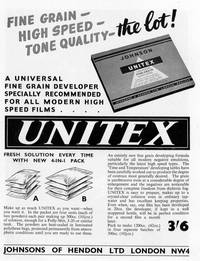 Click on the image to enlarge |
|
|
|
||
|
CAPITOL Introduced in 1953. For use when maximum film speed is desired. Most films (but not all) show an effective speed increase of 200-300%. Johnsons did not recommend 'Capitol' for general use; it was a developer for times when a significant film speed increase was essential. It was reviewed in 'Photography' magazine edition for August 1953 but, strangely, the reviewer used a film NOT recommended by Johnsons for development in Capitol. Johnsons wrote a protest letter which 'Photography' printed in full in their September 1953 issue. To be diluted 1:4 or 1:7. Cost 225cc 3/6d (17.5p), 570cc 6/6d (32.5p), 2¼ litres 17/6d (87.5p). |
||
|
|
||
|
CON-SOL Introduced around 1953. "The best print developer you have ever used". Highly concentrated; especially intended for the Photo-Finisher trade making contact prints. Produces fine blue-black images on all makes of contact papers and rich black tones on all bromide and chlorobromide papers. It offers a considerable degree of control during developing. It was reviewed in the BJPA for 1953 (p 255) who reported enthusiastically on its properties. Most economical, dilute 1:7 for contact prints and up to 1:12 for bromide papers. Cost for commercial size packings: 0.5gallon to make 4gallon of working strength, 11s 6d (57.5p) and 4.5gallons to make 36gallons working strength, £4.16s.9d (£4.84p). Amateur packs subsequently became available; 115cc 2/6d (12.5p), 225cc 3/6d (17.5p), 570cc 5/6d (27.5p). |
||
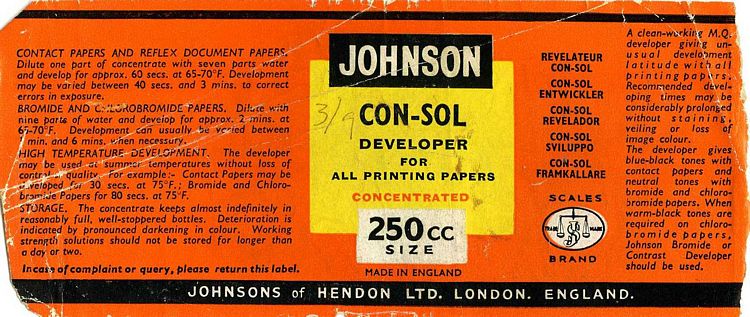 |
||
|
|
||
|
DEFINOL Introduced around 1960. An economical high definition developer for fine grain films in the slow and medium speed ranges. Such films, when developed in an energetic developer, give higher than normal film speeds and an apparent increase in image sharpness due to the Eberhard effect. Grain is fine enough for 20 at least diameter enlargements. Fresh developer is used for each film. The concentrate keeps well in reasonably full stoppered bottles. The 1962 cost for 100cc was 3/- (15p), 500cc 10/- (50p). |
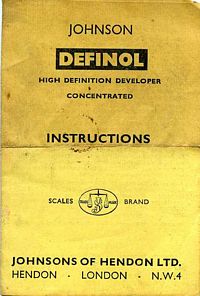 Click on the image above to enlarge. |
|
|
|
||
|
SOLUFIN Introduced maybe summer 1964 (AP issue for 2nd September 1964 has a front cover advert for Solufin in the form of a picture taken by Kevin MacDonnell.) The Johnson 1965 Year Book describes Solufin as a no compromise Extra Fine Grain Developer. A 'specialist' developer that does its job well. For the specialist photographer who knows what he wants. Does not adversely affect definition, though 'Definol' is advised where high definition is required. Its effect on film speed is hardly noticeable. Johnsons admitted the impossibility of concentrating a developer like Solufin to the same extent as Unitol. Hence the developer was supplied as a liquid concentrate in 250cc plastic bottles which made 600cc of working strength solution. Both concentrate and working strength were claimed to have good keeping properties. The 1965 cost for 250cc of concentrate was 5/- (25p). Solufin seems not to have been marketed for long (maybe to 1970), possibly because of the market preference for high definition developers at the time (emulsions were inherently much finer grained than hitherto) and perhaps also to do with Johnsons becoming distributors (by 1967) for Paterson's range of developers. |
 Click on the image to enlarge |
|
|
|
||
|
UNIBATH A combined developer and fixer, introduced in early 1961 (Ref Cameras & Equipment, January 1961). Made in the UK by Johnsons under licence from the Cormac Chemical Co., New York. Unibath is a one-step solution for use with black & white films. Dilute Unibath with an equal quantity of water, pour it into the developing tank and then leave the film to develop and fix itself. Exact temperature and time control is not required. A 250cc bottle cost 5shillings (5/- = 25p) while a 500cc bottle cost 8s.9d (44p). |
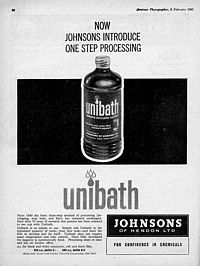 Click on the image to enlarge |
|
|
|
||
|
GOLD TONING & FIXING
This pack of print toning Johnson & Sons "Scaloids", dates from pre-1927, as it bears the address of 23 Cross St, Finsbury, London.
The Directions on the large tubes state "Dissolve one of each Nos. 1, 2 & 3 in each Ounce (28.3ml) of water. The No.1 "Scaloids" should be added after the Nos. 2 and 3 have been dissolved. |
_address.jpg) |
|
|
||
|
|
||
|
SEPIA TONER A "Twin" pack 'Pactum' of Sepia Toner, to tone photograpic prints, enlargements and lantern slides.
|
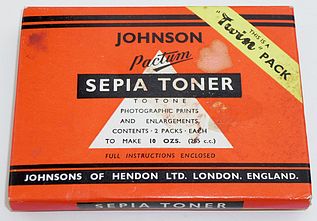 |
|
|
|
||
|
COPPER INTENSIFIER An ideal intensifier for use on weak negatives where only moderate intensification is desired. Also useful for toning bromide prints purple to brick red. Available in bottles to make 850cc 2/6d (12.5p) or as a handy 'Pactum' of powder sufficient to make 285cc, cost 1/- (5p). Illustrated is a Johnsons 'Pactum' Twin Pack of Copper Intensifier. |
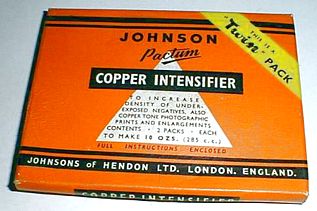 Click on the image to enlarge |
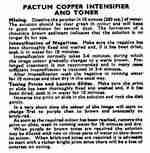 Click on the image to enlarge |
|||||||||||||||||||||
|
|
|||||||||||||||||||||||
|
A simple one solution process which will considerably improve very thin negatives, adding density to the image, thus making it possible to secure good prints. Cost of an early 115cc bottle was 2/- (10p). The picture of the bottle shown alongside (a later 100cc packaging) has been sent to me by Ron Camp, who remembers using it 40 years ago after acquiring it (unopened) from a school friend around 1963. It probably cost around 3/- (15p) at that time. Ron recalls using it to intensify some very under-exposed negatives and remembers the resulting reddish-brown colour of the intensified negatives. |
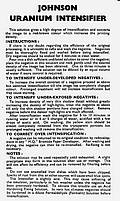 Click on the images to enlarge. |
||||||||||||||||||||||
| PhotoGuide magazine,
December 1956, replied to a reader's query about intensifying
negatives without risking an increase in grain size. "Uranium intensifier probably has the least effect on grain since intensification depends to a large extent on the image changing to a reddish colour and not on an increase in the bulk of the material forming the image. It is put up by Johnsons as a single solution process. The negative is first thoroughly washed, in several changes of water, and then immersed in the intensifier until the desired intensification is achieved. An advantage of uranium is that if you make a mistake, or wish to remove the effects of the intensification for any other reason, this is simply done by immersing the negative in an alkaline solution, such as a weak soda solution. After thorough washing, you can then intensify again if you want to. If you have intensified insufficiently at the first attempt, you can return it to the solution and intensify further ; if you overshoot the mark, you bring the negative back to its original state in soda solution, and start again". |
|||||||||||||||||||||||
|
|
|||||||||||||||||||||||
|
FARMER'S REDUCER (named after inventor Howard Farmer) To remove slight fog from normal or line negatives or to increase the contrast of a dense flat negative. Use either as a one solution or two solution process. 'Pactum' containing two packets of powder, each to be dissolved separately, to make 145cc of the two solutions. A single (2-chemical) pack cost 7½d (3p) in the early 1950s, but by around 1957 a 'Twin' pack Pactum, as illustrated here, cost 1s.6d (7.5p). This unused Pactum 'Twin' Pack, containing 4 packets (2 of each chemical, probably potassium ferricyanide and sodium thiosulphate = hypo), was kindly donated by Shuna Paterson. |
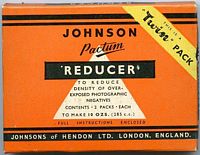  |
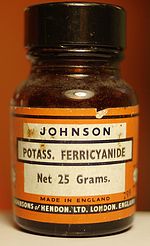 |
|||||||||||||||||||||
|
|
|||||||||||||||||||||||
|
NEGATIVE DYE This 1oz (nett) bottle of Johnson & Sons' Photographic Negative Dye, was donated by Brian Rees. It was intended for retouching and adding density to parts of (large) negatives which printed too deeply. The instructions on the packaging reads: For retouching and adding density.
Soak the negative in water for a few minuts. Dilute a little
of the dye with water to a grey colour, then apply with soft
brush. Around 1953 it was sold at 1s 9d (9p) for the 1oz bottle, but the illustrated bottle must date pre-1949 as it bears the name Johnson & Sons, Manufacturing Chemists, Ltd, rather than Johnsons of Hendon.
|
|
||||||||||||||||||||||
|
WHITE INK A bottle of photographic white
ink, sold for "naming Lantern Slides, ruling and decorating
Photo' Mounts etc". Image sent by Darren Balchin |
|
||||||||||||||||||||||
|
|
|||||||||||||||||||||||
|
JOHNSON STOP BATH Although the use of an acid stop bath between the print developer and the fixing bath was a near universally applied procedure, this particular tin of stop bath (picture courtesy of Tony Pritchard) for some reason particularly refers to preventing stains on gaslight paper (i.e. contact paper; excludes mention of bromide paper) and prolonging the life of the fixing bath. The tin shown could be used to make 2 gallons of stop bath, so most likely used by a commercial processor. The price was as shown, 1s/9d, almost 9p, in probably the early 1950s, as the term gaslight paper was replaced by the name contact paper (same material) in the 1950s when the use of room gaslighting became less common. |
|
||||||||||||||||||||||
|
|
|||||||||||||||||||||||
|
ACID HYPO FIXING POWDER A 250gramme tin of Johnsons Hypo Fixing Powder, as was part of a No.1 Home Photography Outfit. Photographic fixer is a chemical used in the final step in the photographic processing of film or paper. The fixer stabilises the image, removing the unexposed silver halide remaining on the photographic film or photographic paper, leaving behind the reduced metallic silver that forms the image, making it insensitive to further action by light. Without fixing, the remaining silver halide would quickly darken and cause fogging of the image. The chemical compound used is sodium thiosulphate - commonly called "hypo". |
|
||||||||||||||||||||||
|
In 'The Johnson Photographic Year Book 1962', the list of chemicals available to the amateur for home darkroom d&p remains much as set out above and the costs have been well controlled, typically showing a 20-30% increase. Some rationalisation has taken place. The 'Super Fine Grain', 'MCM 100' and 'Chloroquinol' developers have seemingly been abandoned and 'Fine Grain' remains as the only Wellcome 'Tabloid' left in the range. A 'Chromium Intensifier' has been introduced, 100cc for 3/- (15p). The 1962 Year Book also mentions the Ferraniacolor (slide) Processing Outfit, sold in 2 Parts, each 5/6d (27.5p, the same price since its introduction in 1956), plus many 'Developing Agents and Special Chemicals for Colour Processing'. |
|||||||||||||||||||||||
|
|
|||||||||||||||||||||||
|
|
|||||||||||||||||||||||
 |
'Rigidex' plastic bottles, in place of glass, were introduced for the start of September 1961 (Ref: 'Camera' magazine, 'Snap Shots'). For spring 1968, a new label design was created for Johnson Chemicals. To avoid any possible confusion in the darkroom all the fixing preparations were given a BLUE background label. Under a darkroom lamp this colour appeared very dark. General purpose developers (film & print) retained the familiar ORANGE label, appearing quite light under an orange darkroom (printing paper) safe lamp. Developers for negative materials only (like Unitol) received a RED background colour label. Other darkroom products, like glazing solutions, dri-mount, film cement etc, which have nothing to do with developing and fixing, received GREEN labels. The chemical range at this time comprised (film developers) Definol, Solufin, Unitol, Universol, Fine Grain and (print developers) Soluprint, Universol, Contrast, Con-Sol, Bromide, '468' and M-Q (in powder form). There was also the monochrome reversal processing outfit, '328' wetting agent, '142' anti-fog solution and an Anti-Oxidant Spray (A.O.S) inert gas to 'spray' into part-used bottles of developer to prevent oxidation, a Glazing Solution and a Dri-Mount print mountant. Fixers comprised of Fix-Sol
and Redifix Rapid Hardener (both in concentarte form) plus Fixadon
and Acid-Hypo (both in powder form). |
||||||||||||||||||||||
 |
SPEEDWASH (advertisement from the back
page of Photography magazine for February 1969). Dilute 1 in 20 with water. For negatives, agitate for 2 minutes. You can then cut washing time from 30 to 5 minutes. For prints, immerse for 4 minutes. Then 10 minutes water washing is as effective as the usual 45 minutes. 600c cost 6s (30p) to make 2 litres of working strngth solution. |
||||||||||||||||||||||
| At this time, spring 1968, Johnsons were also agents for the Paterson range of photographic equipment and chemistry. Johnsons were advertising the Paterson chemical range, consisting of Acutol (high acutance with for 5-200ASA monochrome films), Acutol S (as Acutol but suitable for all film speeds), FX-18 (an M-Q type developer using Phenidone, hence a P-Q developer), Acuspeed FX-20 (a film speed enhancing developer) and Acuprint FX-17 (a high development latitude print developer). | |||||||||||||||||||||||
|
|
|||||||||||||||||||||||
|
|
|||||||||||||||||||||||
|
By January 1970, the Amateur Photographer magazine carried the Johnsons of Hendon advert opposite. Only three developers are shown; Universol, now costing 4/6d (22.5p) for 250cc and 7/3d (36.5p) for 500cc, an average increase of 80% since 1950. Unitol, now costing 4/6d (22.5p) for 240cc and 8/6d (42.5p) for 500cc, an average increase of 45% since 1951. SoluPrint, described as a professional 'Phenidone' paper developer now available in smaller sizes for the amateur. Long dish life and great latitude to enable just the right print contrast. Dilute 1:9 or just experiment! Cost 250cc 4/6d (22.5p) and 500cc 7/3d (36.5p). A monochrome film reversal processing outfit is also shown, to be used with Universol developer and any acid hardening fixer. Cost to process 4-8 films 6/6d (32.5p). The formula had been made available for a number opf years previous and continued to be available (Information Sheet 110/C) even after Johnsons brought out their monochrome reversal processing outfit. I used such a kit around 1966. It was reviewed in the Amateur Photographer issue for 16th October 1963 under the title "What's New?", when the kit cost 6/- (30p). AP calculated an overall cost between 1/6d to 2/- (7.5p to 10p) to process a 35mm film. They were impressed with the results and recommended its use with FP3 series II film. |
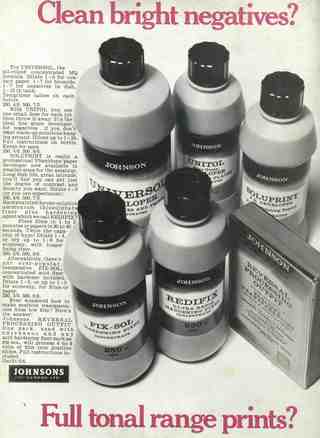 Click on the image above to enlarge. |
||||||||||||||||||||||
|
To download the Johnson booklet (dated June 1968) of their Reversal Processing Outfit, click the image or here. |
|||||||||||||||||||||||
|
The Johnson monochrome film
reversal processing kit is no longer available, but the following
might help anyone wishing to try black & white reversal processing.
Use the same processing step times as those as in the Johnson numbered sequence, above. Johnsons Universol developer
is no longer made, but any fairly energetic film developer would
probably do as well. A fairly strong light is required to fog the film before the Second Development; If the film is removed from it's developing tank spiral, then exposing each side of the film for 30seconds at 0.5m from a 100 watt bulb, should suffice, or 1minute at the distance specified if the film is left in a transparent spiral. Any good black and white film fixer will do for the final fixing step (but such fixers are not Hypo and so should not be used in the First & Second Developers). |
|||||||||||||||||||||||
|
|
|||||||||||||||||||||||
|
In the final 9th edition of 'Home Photography', which I believe dates to around 1970, apart from Unitol, Universol and a pack of powdered Fine Grain developer, Definol is also mentioned. Johnsons had taken over distribution of Paterson products from R.F Hunter in 1967, and so Paterson developers are also being illustrated and promoted. In the 9th edition of 'Home Photography' a tin of Paterson's FX-18, a reusable fine grain P.Q. Borax (Phenidone and Hydroquinone) developer is shown and Paterson Acutol is mentioned alongside Johnsons' own Definol. Paterson Acuspeed FX-20 (extends the speed rating of high speed films) and Acuspecial FX-21 (edge definition developer for slow to medium speed films) are also mentioned in the 'Home Photography' text. These Paterson developers appear in Paterson's own leaflet for 1973/74 but by 1985 the FX-18 and FX-21 have disappeared and Acutol is renamed FX-14. See this page for more detail. |
|||||||||||||||||||||||
|
|
|
||||||||||||||||||||||
|
|
|||||||||||||||||||||||

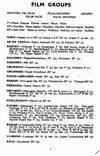
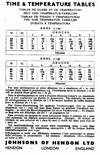
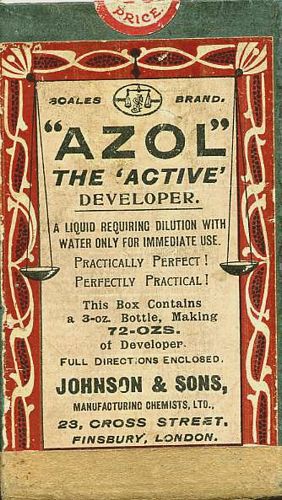
.jpg)
.jpg)
.jpg)
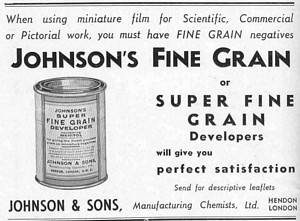 Formulations
for Fine Grain and Super Fine Grain developers date to before
1948, when Johnsons of Hendon were still trading as Johnson &
Sons, Manufacturing Chemists, Limited.
Formulations
for Fine Grain and Super Fine Grain developers date to before
1948, when Johnsons of Hendon were still trading as Johnson &
Sons, Manufacturing Chemists, Limited.

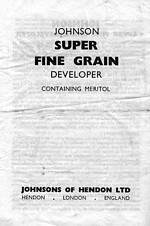
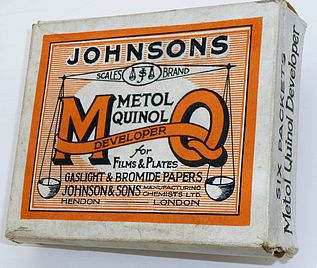 The above single 'Pactums' were also
sold in boxes of six.
The above single 'Pactums' were also
sold in boxes of six. The
reverse side of the six Pactum
M-Q developer pack (see opposite).
The
reverse side of the six Pactum
M-Q developer pack (see opposite).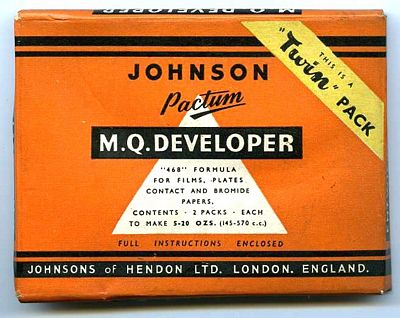 This slim carboard outer pack contained
4 packets of powder, each pair sufficient to make up to
200cc for developing contact paper prints, 285cc for developing
bromide prints or between 450cc and 570cc when developing films.
This slim carboard outer pack contained
4 packets of powder, each pair sufficient to make up to
200cc for developing contact paper prints, 285cc for developing
bromide prints or between 450cc and 570cc when developing films.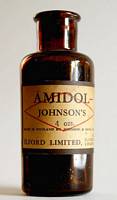


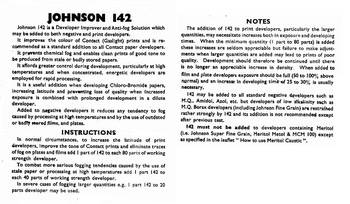
_Scaloids.jpg)
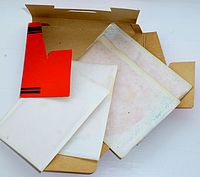 The
content consists of 4 heat-sealed moisture proof packets, in
2 pairs, each pair having one white powder and one orange powder
packet. Each powder was to be separately dissolved in 10 fluid
ounces (285ml) of water. The orange powder formed a bleach while
the white powder solution subsequently applied the colour tone.
This pack dates to January 1966 when it cost 2shillings (10p).
The
content consists of 4 heat-sealed moisture proof packets, in
2 pairs, each pair having one white powder and one orange powder
packet. Each powder was to be separately dissolved in 10 fluid
ounces (285ml) of water. The orange powder formed a bleach while
the white powder solution subsequently applied the colour tone.
This pack dates to January 1966 when it cost 2shillings (10p).
.jpg)
.jpg)
.jpg)
